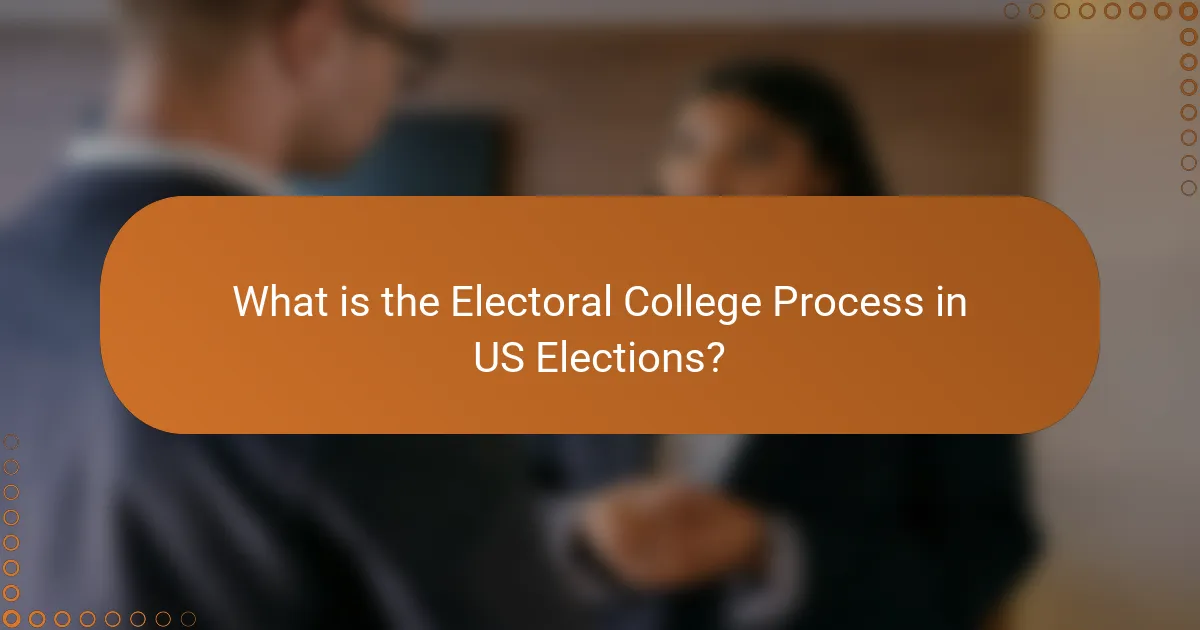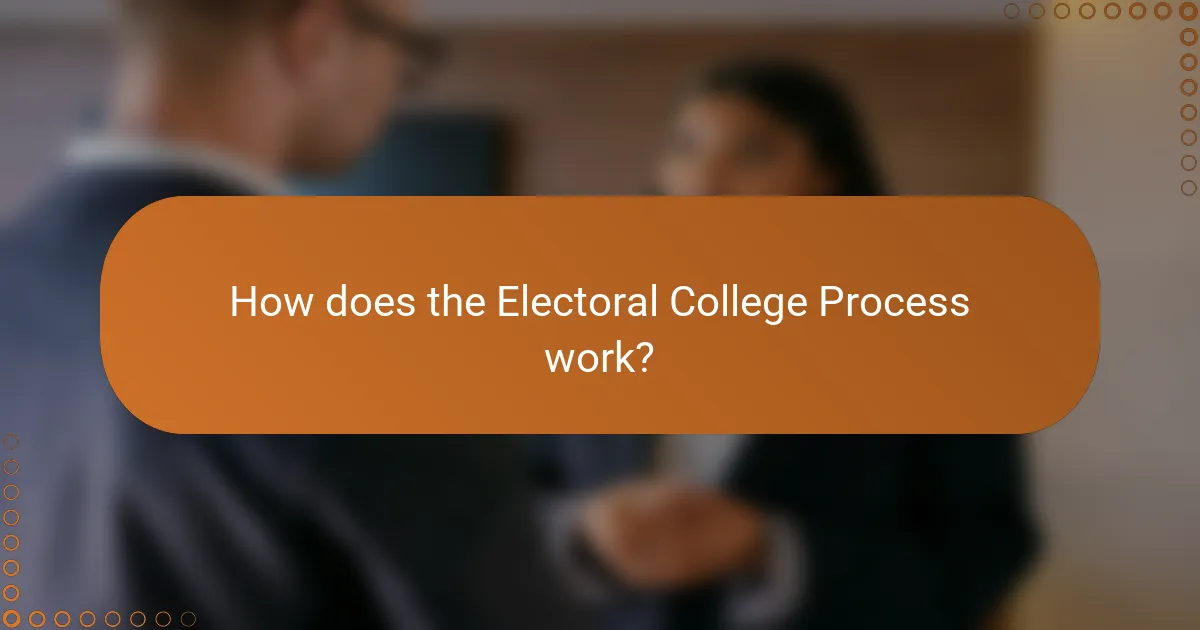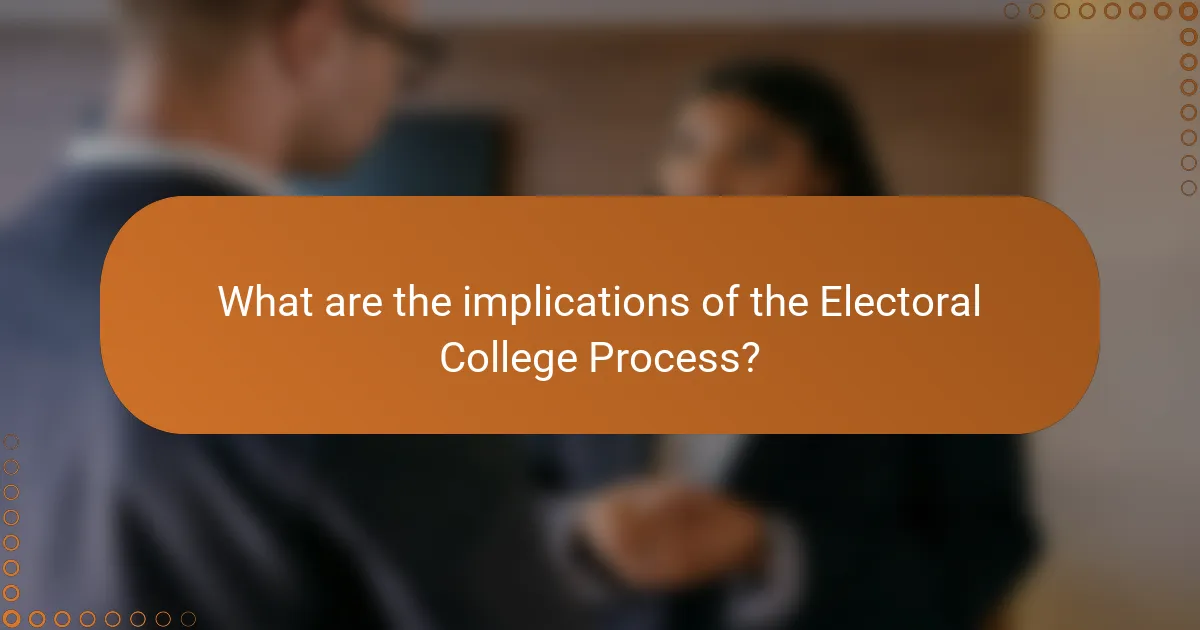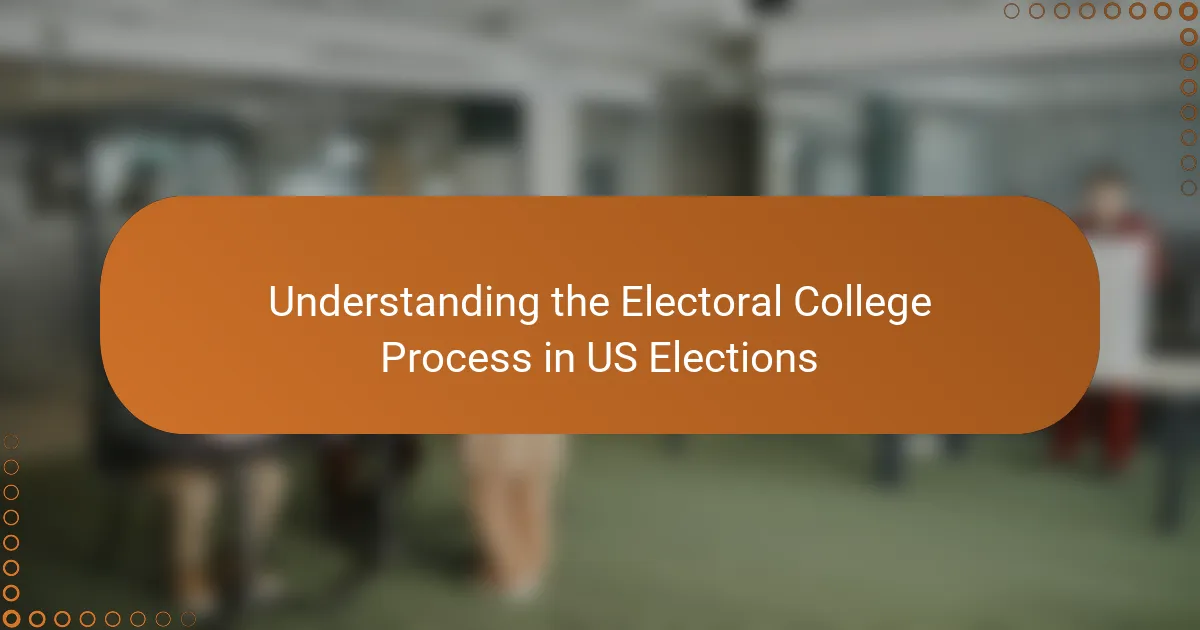The Electoral College is the mechanism established by the U.S. Constitution for electing the President and Vice President of the United States. Comprising 538 electors, each state is assigned a number of electors based on its congressional representation, requiring a candidate to secure at least 270 electoral votes to win the presidency. Voters cast ballots for electors pledged to specific candidates, with most states employing a winner-takes-all system. Following the election, electors formally cast their votes in December, which are then certified by Congress in January. This process has significant implications for campaign strategies, voter engagement, and the overall democratic nature of U.S. elections, including instances where candidates have won the presidency without the popular vote.

What is the Electoral College Process in US Elections?
The Electoral College process is the mechanism established by the U.S. Constitution for electing the President and Vice President. Each state is allocated a number of electors equal to its total number of Senators and Representatives in Congress. There are a total of 538 electors in the Electoral College. To win the presidency, a candidate must receive a majority of the electoral votes, which is at least 270.
During the presidential election, voters in each state cast their ballots for a slate of electors pledged to a specific candidate. Most states use a winner-takes-all system, where the candidate receiving the most votes in that state gets all its electoral votes. After the election, electors meet in their respective state capitals to formally cast their votes for President and Vice President. This meeting occurs on the first Tuesday after the second Wednesday in December.
The electoral votes are then certified by Congress in early January. If a candidate receives the necessary 270 votes, they are declared the winner of the election. This process has been in place since the founding of the United States, with the first Electoral College election taking place in 1788.
How was the Electoral College established?
The Electoral College was established by the United States Constitution in 1787. It was created as a compromise between electing the president by a vote in Congress and by popular vote. The Founding Fathers aimed to balance the influence of populous states with less populous ones. Article II, Section 1 of the Constitution outlines the framework for the Electoral College. Each state is allocated a number of electors equal to its total number of Senators and Representatives. This system ensures that smaller states still have a significant voice in presidential elections. The first presidential election under this system occurred in 1789. The Electoral College has undergone some changes since its inception, but its fundamental structure remains intact.
What were the historical contexts influencing its creation?
The Electoral College was created in response to the challenges of electing a president in a large, diverse nation. The Founding Fathers aimed to balance the influence of populous states with less populated ones. They were concerned about direct democracy leading to mob rule. The compromise was influenced by the need to maintain the union among states with varying interests. The Constitutional Convention of 1787 debated various methods of election. Ultimately, the Electoral College was established as a compromise between direct popular vote and election by Congress. This system was intended to ensure that all states had a voice in the election process. The historical context included fears of tyranny and the desire for a stable government.
Who were the key figures involved in its establishment?
The key figures involved in the establishment of the Electoral College were the Founding Fathers of the United States. Notable individuals include Alexander Hamilton, who advocated for the system in Federalist No. 68. James Madison also played a critical role in the Constitutional Convention discussions. George Washington, as the first President, influenced its implementation. The Electoral College was established in 1787 as part of the U.S. Constitution. It aimed to balance the influence of populous states with smaller ones. This compromise reflected the political landscape and concerns of the time.
What role does the Electoral College play in US elections?
The Electoral College is a mechanism established by the U.S. Constitution for electing the President and Vice President. It consists of 538 electors, with a majority of 270 needed to win the presidency. Each state has a number of electors equal to its total congressional representation. Voters in each state cast ballots for a slate of electors pledged to a particular candidate. These electors then formally elect the President and Vice President. The system is designed to balance the influence of populous states with less populous ones. The Electoral College has been used in every presidential election since 1789. It reflects a compromise between direct popular vote and congressional selection of the president.
How does it influence the outcome of presidential elections?
The Electoral College significantly influences the outcome of presidential elections in the United States. It determines how votes are translated into electoral votes. Each state has a set number of electoral votes based on its population. A candidate needs a majority of these electoral votes to win the presidency. This system can lead to scenarios where a candidate wins the popular vote but loses the election. For example, in 2000 and 2016, candidates won the presidency despite receiving fewer popular votes. The winner-takes-all approach in most states amplifies this effect. Thus, the Electoral College shapes campaign strategies and voter engagement across different states.
What are the main functions of the Electoral College?
The main functions of the Electoral College are to formally elect the President and Vice President of the United States. The Electoral College consists of 538 electors. A candidate needs a majority of 270 electoral votes to win. Each state’s number of electors is based on its congressional representation. This system balances influence between populous and less populous states. The Electoral College also serves to maintain the federal character of the nation. It ensures that all parts of the country have a role in the election process. Established by the U.S. Constitution, it reflects the compromise between direct popular vote and congressional selection.
Why is the Electoral College a topic of debate?
The Electoral College is a topic of debate due to concerns about its fairness and representation. Critics argue that it can lead to unequal weight of votes across states. For instance, smaller states receive a disproportionately higher number of electoral votes relative to their population. This system can result in a candidate winning the presidency while losing the popular vote, as seen in the elections of 1824, 1876, 1888, and 2000. Supporters claim it protects minority interests and encourages candidates to campaign nationwide. However, opponents argue it undermines democratic principles by not reflecting the direct will of the people. The debate continues as calls for reform grow, especially after contentious elections.
What are the arguments for maintaining the Electoral College?
The arguments for maintaining the Electoral College include preserving federalism and protecting minority interests. The Electoral College ensures that smaller states have a voice in presidential elections. It prevents populous states from dominating the election process. This system encourages candidates to campaign in diverse regions. It promotes national unity by requiring candidates to gain support across various states. Historical context shows the framers intended to balance state and popular interests. The Electoral College has been a stable mechanism for over 200 years. It encourages a two-party system, which can lead to political stability.
What are the arguments for reforming or abolishing it?
Arguments for reforming or abolishing the Electoral College include concerns about representation and fairness. Critics argue that the system disproportionately favors smaller states. This leads to candidates focusing their campaigns on these states while neglecting larger populations. Additionally, the winner-takes-all approach in most states can result in a candidate winning the presidency without the popular vote. Historical data shows that this has occurred in elections such as 1824, 1876, 1888, 2000, and 2016. Reform advocates suggest alternatives like the National Popular Vote Interstate Compact to ensure every vote carries equal weight. They argue that a direct popular vote would enhance democratic legitimacy.

How does the Electoral College Process work?
The Electoral College process determines the outcome of U.S. presidential elections. Each state is allocated a number of electors based on its congressional representation. There are a total of 538 electors in the Electoral College. To win the presidency, a candidate must receive a majority of the electoral votes, which is at least 270.
During the presidential election, voters cast their ballots for a slate of electors pledged to vote for their chosen candidate. Most states use a winner-takes-all system, where the candidate receiving the most votes in that state gets all its electoral votes. After the election, electors meet in their respective state capitals in December to cast their votes for president and vice president.
These votes are then certified and sent to Congress. In January, Congress officially counts the electoral votes in a joint session. If a candidate receives 270 or more votes, they are declared the winner of the election. This process has been in place since the ratification of the U.S. Constitution in 1788.
What are the steps involved in the Electoral College process?
The Electoral College process involves several key steps. First, citizens cast their votes on Election Day. These votes determine which electors will represent each state. Each state has a set number of electors based on its congressional representation. After the election, electors meet in their respective state capitals in December. They formally cast their votes for President and Vice President. These votes are then certified and sent to Congress. In January, Congress counts the electoral votes during a joint session. Finally, the candidates who receive a majority of electoral votes are declared the winners. This process is outlined in the U.S. Constitution and has been followed since its establishment.
How are electors chosen in each state?
Electors are chosen in each state through a process determined by state law. Most states use a winner-takes-all system, where the candidate receiving the majority of votes gets all electoral votes. Some states allocate electors proportionally based on the vote percentage. Each state has a specific number of electors, equal to its total congressional representation. This includes both senators and representatives. The selection of electors often occurs during party conventions or through state party committees. Electors are usually individuals loyal to their political party. They are pledged to vote for the party’s chosen candidate in the Electoral College.
What happens during the Electoral College voting process?
During the Electoral College voting process, electors formally cast their votes for President and Vice President. This event occurs on the first Tuesday after the second Wednesday in December following the presidential election. Each elector submits a ballot that lists their chosen candidates. The total number of electoral votes is 538, and a majority of 270 is required to win. The votes are counted and certified by the President of the Senate in a joint session of Congress. This certification takes place in early January. The process is outlined in the U.S. Constitution and further defined by federal and state laws.
How does the allocation of electoral votes work?
Electoral votes are allocated based on the number of representatives each state has in Congress. Each state has a total equal to its number of Senators, which is always two, plus its number of Representatives in the House. The total number of electoral votes is 538, with a majority of 270 needed to win the presidency. States with larger populations have more representatives and, therefore, more electoral votes. The allocation can also reflect census data, which can change the number of representatives after each decennial census. For example, California has 55 electoral votes due to its large population, while Wyoming has 3 electoral votes as the minimum for any state. This system aims to balance the influence of populous states with less populous ones in presidential elections.
What determines the number of electoral votes per state?
The number of electoral votes per state is determined by the total number of its congressional representatives. Each state receives electoral votes equal to its number of Senators, which is always two, plus the number of Representatives it has in the House. The total number of Representatives is based on the state’s population as measured by the decennial census. Therefore, states with larger populations have more Representatives and, consequently, more electoral votes. For instance, California has 55 electoral votes due to its large population, while states with smaller populations, like Wyoming, have a minimum of three electoral votes. This system is established by the U.S. Constitution and has been in place since the first electoral vote allocation in 1789.
How does the winner-takes-all system function?
The winner-takes-all system awards all of a state’s electoral votes to the candidate receiving the most votes in that state. This system is used by 48 of the 50 states in the U.S. For example, if a candidate wins 51% of the votes in a state, they receive all of that state’s electoral votes. This method can lead to a situation where a candidate wins the presidency without winning the overall popular vote. In 2000 and 2016, candidates achieved this outcome. The system encourages candidates to focus on winning individual states rather than the national popular vote.

What are the implications of the Electoral College Process?
The Electoral College process has significant implications for U.S. presidential elections. It influences the way candidates campaign and allocate resources. Candidates focus on swing states due to their electoral votes. This can lead to unequal attention between states. For example, smaller states may have disproportionate influence relative to their population. The process can also result in a president winning without the popular vote. This has occurred in several elections, including 1824, 1876, 1888, 2000, and 2016. Such outcomes raise questions about the democratic nature of the election system. The Electoral College can also impact voter turnout in non-swing states. Voters in these states may feel their votes carry less weight. Overall, the implications of the Electoral College shape the political landscape and voter engagement in the U.S.
How does the Electoral College affect voter turnout?
The Electoral College can significantly affect voter turnout by influencing perceptions of electoral competitiveness. In states where one party dominates, voters may feel their individual votes have less impact, leading to lower turnout. Conversely, in battleground states, heightened competition can motivate more voters to participate. Research shows that voter turnout is typically higher in states with close races. For example, the 2020 election saw higher turnout in key swing states like Pennsylvania and Michigan compared to states with predictable outcomes. This pattern highlights how the structure of the Electoral College can shape voter engagement and participation levels across the nation.
What trends have been observed in voter participation across states?
Voter participation trends across states show significant variation. States with same-day registration often report higher turnout rates. For example, Minnesota consistently ranks among the highest in voter participation, with rates exceeding 80% in some elections. Conversely, states with strict voter ID laws tend to experience lower participation. In 2020, states like Georgia and Texas saw increased voter turnout, attributed to heightened engagement efforts. Additionally, younger voters are increasingly participating, with a notable rise in turnout among those aged 18-29 in recent elections. Overall, the national trend indicates a gradual increase in voter participation, influenced by factors such as accessibility and voter mobilization initiatives.
How do swing states impact the Electoral College dynamics?
Swing states significantly influence Electoral College dynamics by determining the outcome of presidential elections. These states often have a mix of voters from both major political parties. Their electoral votes can sway the overall results, as they are not reliably Democratic or Republican. In the 2020 election, for example, states like Pennsylvania and Wisconsin were crucial in securing victory for Joe Biden. Swing states receive increased campaign attention and resources, as candidates focus on winning these pivotal regions. The presence of swing states can lead to more competitive elections, impacting voter turnout and campaign strategies. In the 2016 election, Donald Trump’s victories in swing states like Michigan and Florida were key to his Electoral College win. Thus, swing states play a vital role in shaping the electoral landscape in the United States.
What are the potential reforms to the Electoral College?
Potential reforms to the Electoral College include the National Popular Vote Interstate Compact, abolishing the Electoral College, and proportional allocation of electoral votes. The National Popular Vote Interstate Compact would require states to award their electoral votes to the candidate who wins the national popular vote. This reform aims to ensure that the president is elected by a majority of voters. Abolishing the Electoral College entirely would shift the U.S. to a direct popular vote system for presidential elections. Proportional allocation would distribute electoral votes based on the percentage of votes each candidate receives in a state. These reforms are discussed in various political forums and have gained traction among advocates for electoral reform.
What alternative systems have been proposed?
Alternative systems proposed to the Electoral College include the National Popular Vote Interstate Compact (NPVIC) and ranked-choice voting. The NPVIC aims to ensure that the candidate receiving the most popular votes nationwide wins the presidency. It requires participating states to allocate their electoral votes to the national popular vote winner, effectively bypassing the Electoral College. Ranked-choice voting allows voters to rank candidates in order of preference. This system can lead to a more representative outcome by ensuring that the winning candidate has broader support. Various states have considered or implemented these systems, demonstrating a shift towards more direct democratic practices in U.S. elections.
How would these reforms change the electoral landscape?
These reforms would significantly alter the electoral landscape by promoting a more equitable representation of voters. Implementing ranked-choice voting could reduce the impact of strategic voting. This allows voters to express preferences without fear of wasting their votes. Additionally, reforms like the National Popular Vote Interstate Compact would shift focus from state-by-state electoral outcomes to the overall national vote. This change could lead to candidates prioritizing broader national issues rather than catering to swing states. Historical evidence shows that electoral reforms often lead to increased voter engagement. For instance, states that adopted automatic voter registration saw higher turnout rates. Overall, these reforms aim to create a more democratic and inclusive electoral process.
What should voters know about the Electoral College?
The Electoral College is the system used to elect the President of the United States. It consists of 538 electors, with a majority of 270 needed to win the presidency. Each state has a certain number of electors based on its population and congressional representation. Voters in each state cast their ballots for a slate of electors pledged to a specific candidate. This process means that winning the popular vote in a state typically secures all of its electoral votes. Some states use a proportional system, but most adhere to a winner-takes-all approach. The Electoral College has been in place since the Constitution was ratified in 1788. Critics argue it can lead to a disparity between the popular vote and the electoral outcome. For instance, in the 2000 and 2016 elections, candidates won the presidency without winning the popular vote.
How can voters influence the electoral process within their states?
Voters can influence the electoral process within their states by participating in elections and engaging in advocacy. Voting is the primary method for citizens to express their preferences for candidates and policies. Active participation in local and state elections can shape the political landscape. Voters can also influence the process by contacting their representatives to express opinions on legislation. Grassroots movements and campaigns can mobilize public support for specific issues. According to the U.S. Census Bureau, approximately 66.8% of eligible voters participated in the 2020 presidential election, demonstrating the impact of voter turnout. Additionally, initiatives and referendums allow voters to directly decide on policy issues. Engaging in discussions and debates can raise awareness and encourage informed voting.
What resources are available for understanding the Electoral College better?
Books, articles, and online resources are available for understanding the Electoral College. “The Electoral College: A Critical History of the System” by Robert M. Alexander provides a comprehensive overview. The National Archives website offers official information and historical context. Additionally, the Center for American Progress has articles explaining the mechanics and implications of the Electoral College. Educational platforms like Khan Academy provide video content on the topic. These resources help clarify how the Electoral College functions and its impact on U.S. elections.
The main entity of this article is the Electoral College process in U.S. elections. The article provides a detailed examination of the Electoral College, including its establishment, historical context, key figures involved, and its role in electing the President and Vice President. It outlines the mechanics of how electors are chosen, the voting process, and the implications of the winner-takes-all system. Additionally, the article discusses the ongoing debate surrounding the Electoral College, including arguments for reform and potential alternatives, while highlighting trends in voter participation and the impact of swing states on election outcomes.
